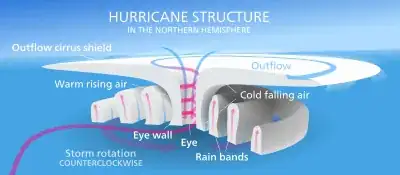Suppose you had a tower-like mega-structure, rooted all the way into near-infinite geo-thermal energy of the Earth's crust, connected to the ocean such that water is not a limiting factor to the super-structure, and extending fully through the atmosphere into space. Is there a plausible way for this mega-structure to maintain a powerful and permanent cyclonic storm around itself?
Specifically, I am interested in a "cyclonic storm" defined as a sort of super-hurricane, a violent, rotating weather system maintained by a vertical superstructure in it's eye. The storm system could be layered along the same lines as earths atmosphere, or it be organized beyond them. (Secondary questions: how wide could the eye be? How wide could the storm get?)
Perhaps by raising heat and moisture into the upper atmosphere and distributing it in a controlled way and/or placing a rotating sunshade in space to control the the thermal contribution of the sun? Perhaps by thermally superconductive materials transferring heat to water or cold moist air? How could the weather be made to spin around a super structure?
EDIT: I received notification that this question could be considered a duplicate of the question, "How can I ensure my Evil Tower is always stormy?" The primary differences are the scale and that the storm is a cyclonic storm around the structure, not floating overhead. The tower-like mega structure in my question reaches space, and would be between 100 and 200 km in diameter at it's base. The storm surrounding it would be broad and powerful enough to affect dramatic watershed change in a radius of 100s of km, and make foot traffic to the structure impossible. Study of Cyclonic storms and the answers I've already received indicate the answers to "How can I ensure my Evil Tower is always stormy?" would not produce these effects. This is not scary cloud, it is a meteorological catastrophe.
